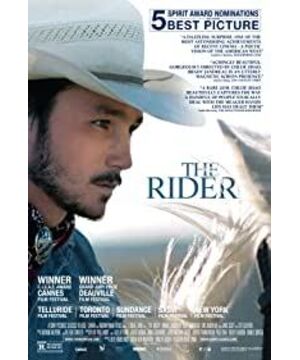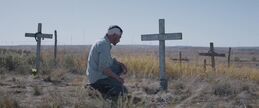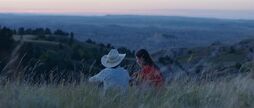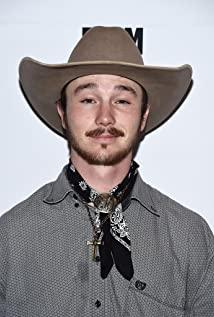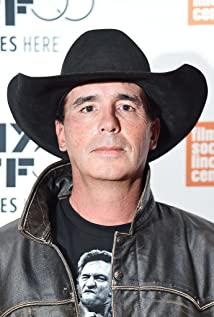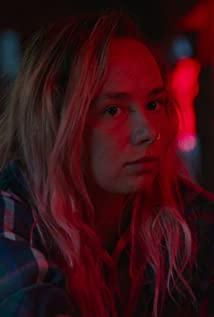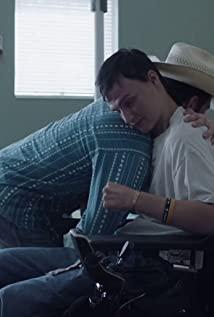(1) The simulacrum of America
After the title of "Knight", the first frame we see is Brady's back, the white gauze wrapped around his head is faintly visible in the dark, and then a series of more detailed shots show him taking medicine. , smoking, removing the gauze, here, all the scenes are mostly close-up and close-up - they share Brady's pain with the audience, and it is more noteworthy that in this scene, Brady is placed in a cramped space.
But the more cramped space comes from the small mobile phone screen, which replaces the flashback. The video on the screen proves that Brady was once a "knight", or that Brady's identity was "given" by it, which is also a The so-called "era of the disappearance of chivalry" is replaced by a more modern word, "simulacrum", that is, the absence of a sense of reality. The simulacra is not in progress, but has been completed.
Before that, Brady's identity was not a knight who ran wild in the desert and wasteland of the western United States, but a knight born between arena events. The arena is a framed desert landscape, a naturalized 19th-century cowboy Duel, omitting the wild west of bison, robber, stagecoach and Indian "red fan", auditorium and fence completed the transformation between "watchable" entertainment.
Welcome to the America of simulacra, where triple "captivity" means a gradual loss of authenticity.
(2) The era of fading light - the type myth of the end
Just as Yamada Yoji relegated the poor samurai in the late shogunate to their homes and kitchens in "Twilight Seibei", Brady, the protagonist of "Knights", has to face a daily space that lacks miracles and adventures: family, supermarket cashiers The mechanical repetition of the station, which is the other side of the American West.
In the Western film genre myths once established by directors such as John Ford and Howard Hawks, Western heroes are usually heroes in the collective sense. They are the defenders of conservative values such as family, collective, and society. They are often associated with Adjectives such as "masculine", "white", "American" connect. But the paradox is this: these heroes of violence and peace are rarely involved in what they protect, even if they admit to being a part of it (where "in" may mean some kind of value), usually, they act alone or in small groups, and keep a certain distance from it. They worship the patriarchy, respect the father, but remain free at the level of "patriarchy"... These "refusals to participate" and "non-community" are often read as a kind of heroic sacrifice, which The reading obscures the opposition between the "unsocial" character and the "protected" and the act of "protecting" among Western heroes. When Brady had to go into these routines and had to be reprimanded by his father, it was here that physical conditions and medical reports became the new judges, proclaiming the dissolution of the hero. ,
In a long-range shot, Brady is staring at a low hill, not the legendary symbolic Monument Valley. He is not John Wayne who rode through Monument Valley in "The Searcher", and he is not a tough silhouette, mouth The Clint Eastwood of cigars exists only as a weak and incomplete male.
Although appearing low and dead in the film, "Knight" retains this heroic spirit, it is about a man trying to regain his lost masculinity, but the "author" who presents these images belongs to a A left-wing identity in the full sense—director Zhao Ting is neither "American", but also "female". If it were not for this identity, "Knight" might not have been completed, because it originated from an imaginary United States, a The collective cynicism of the Trump-era film industry The cultural America of distancing, which is sealed in the Hollywood films of the Golden Age or in the literature of Hemingway, Jack London, is a paradox, in an increasingly “stance” Important era, and strangers, but keen to establish a private land of American culture.
(3) A gentle blow
To a considerable extent, "The Knight" mourns the passing genre myths, a cultural America constructed by film and literature in the eyes of strangers, but at the same time it also gives the "classic" a gentle blow.
It retains the three-part structure, in which the three-part structure of Hollywood films, is the beginning - the first attempt (failure) - the second attempt (success), in the final act of heroic nature, usually ritual Sexually, the film compels the viewer to watch the protagonist act, sharing this congealed and inescapable time, while the final scene in the narrative sense of The Knight, through the ritually presented close-up (of Brady himself and the surrounding viewers) does not. points to his renunciation.
If the film had chosen to end after a twilight vista not long before this scene, where Brady killed his beloved horse named Apollo, "The Knight" would have been another film, with the death of the horse instead Brady ended tragically as a martyr.
"For horses, their goal is to gallop on the prairie, for cowboys, it's equestrian competition..."
These come from Brady's conversation with Lily, and even the sombre tones of the picture suggest a temptation to die, with "die" as the ending.
But Brady is still alive, he must go to the racetrack again and end the identity of the "cowboy" by himself, in this three-stage formula, replace "success" with "give up".
It gave the final blow to the narrative of desire piled up by "Do What You Want", which came from presenting and identifying with Brady's own boundaries, that is, the unreachable horizon limited by "self", in Kerke In Gower's philosophy, this "boundary" usually has a divine nature, it may not belong to God, but it has to be revered. This is Brady's upbringing, and the end of the West.
The knight is forever sealed within the 9.7-inch iPad. Brady and the once equally brilliant knight Lane Scott imitate the posture of horseback riding, but never touch the real horse. Here, he is like a western movie riding out of town alone The cowboy who moved on, or the father who witnessed his daughter marry in Yasujiro Ozu's film.
references
Jean Baudrillard: "America", translated by Zhang Sheng, Nanjing, Nanjing University Press, 1st Edition, October 2011
View more about The Rider reviews


